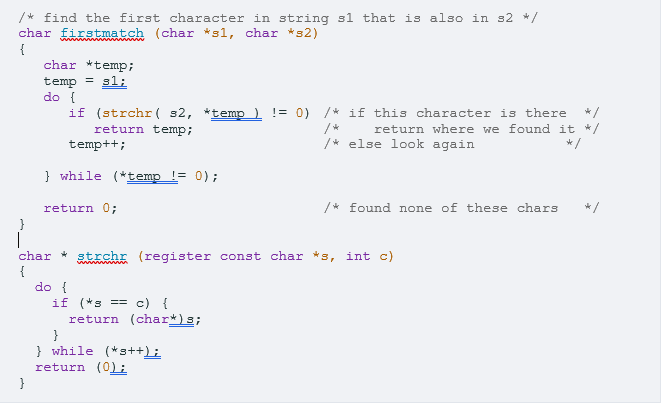/* find the first character in string sl that is also in s2 */ char firstmatch (char *s1, char *s2) { char *temp; temp = sl; do { if (strchr( s2, *temp ) != 0) /* if this character is there */ /* /* else look again return where we found it */ */ return temp; temp++; } while (*temp != 0); return 0; /* found none of these chars */ char * strchr (register const char *s, int c) { do { if (*s == c) { return (char*)s; } } while (*s++Li return (0):
The goal of this lab is to get familiar with how the program described in a high-level language (particularly C) is translated into MIPS assembly language. We will eventually build our own simulator in the next lab assignment. For this lab assignment, we don’t have a simulator to run MIPS assembly, so we will use an existing one, called MPLAB. A basic MPLAB tutorial will be provided separately.
Specifically, translate the following C procedure into MIPS Assembly. You are required to follow the conventional use for registers such as temporary vs. saved registers, maintaining procedure call stacks, proper parameter passing and returns, etc. Note that this procedure calls another (strchr) which is assumed to also comply with those conventions.
/* find the first character in string s1 that is
These are additional instructions to complete this lab assignment.
- The program should consist of two segments: .data and .text segments.
- Define two strings, str1 and str2, in the data segment.
- Use lb (load byte) as you manipulate strings, not integers.
- The code segment, labeled as “.text”, should begin with “main:” because the simulator begins the execution from there.
- In the main code, you should start with the load addresses of the defined str1 and str2.
- You need to write two procedures, firstmatch and strchr, in the code segment, each is labeled as the procedure name.
- After loading string addresses, you pass both strings to firstmatch as in the above C code.
- Within the firstmatch procedure, you need to call the strchr
- When each procedure gets called, you need to follow the procedure calling conventions.
Write your firstmatch procedure, so the do-while loop contains six or fewer

Step by step
Solved in 2 steps









